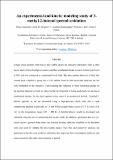Experimental and kinetic modeling study of 3-Methyl-2-butenol (Prenol) oxidation

View/
Date
2021-08-19Author
Lokachari, Nitin
Wagnon, Scott W.
Kukkadapu, Goutham
Pitz, William J.
Curran, Henry J.
Metadata
Show full item recordUsage
This item's downloads: 81 (view details)
Cited 0 times in Scopus (view citations)
Recommended Citation
Lokachari, Nitin, Wagnon, Scott W., Kukkadapu, Goutham, Pitz, William J., & Curran, Henry J. (2021). Experimental and Kinetic Modeling Study of 3-Methyl-2-butenol (Prenol) Oxidation. Energy & Fuels, 35(17), 13999-14009. doi: 10.1021/acs.energyfuels.1c01530
Published Version
Abstract
Longer chain alcohols with 4–5 carbon atoms are attractive alternative fuels as they can be derived from biological sources and since their combustion leads to lower exhaust gas levels of NOx and soot compared to commercial fossil fuels. The auto-ignition behavior of fuels that contain both a hydroxyl group and a C═C double bond in their molecular structure is not well established in the literature. Understanding the influence of these functional groups on the ignition behavior of fuels is critical in the development of tailor-made fuels for advanced combustion engines. In this study, ignition delay times of an unsaturated alcohol, 3-methyl-2-butenol (prenol), are measured using a high-pressure shock tube and a rapid compression machine at pressures of 15 and 30 bar at equivalence ratios of 0.5, 1.0, and 2.0 in “air” in the temperature range 600–1400 K. A detailed kinetic model is developed and validated using the new experimental data in this study. In addition, speciation data in a jet-stirred reactor, ignition delay times, and laminar burning velocities available in the literature were also used to validate the new kinetic model. Fuel flux and sensitivity analyses are performed using this new model to determine the important fuel consumption pathways and critical reactions that affect the reactivity of prenol.

